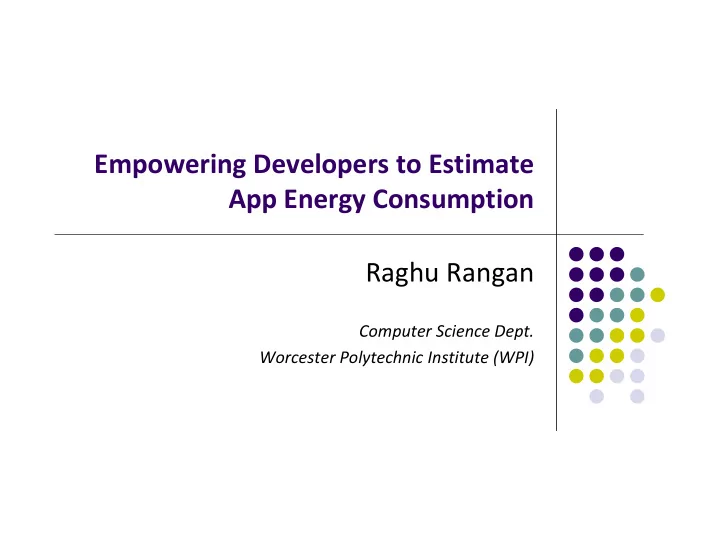

Empowering Developers to Estimate App Energy Consumption Raghu Rangan Computer Science Dept. Worcester Polytechnic Institute (WPI)
Introduction In the world of smartphones there are a number of mobile applications available Games, calendars, social media Poorly written apps can drain the battery of a phone Very frustrating for users
Battery Problems Battery life for smartphones has improved significantly over the past several years Lot of work has been done to improve battery life Focus on the platform itself Battery density, low power processors, the cloud But this work only focuses on the platform itself Poorly written programs can still destroy battery life
Goal Create a system which allows developers “to estimate the energy consumed by his/her app in the development environment itself”
Current Offerings for Users PowerTutor Screenshot
Related Work Large body of work on energy modeling for phones Specifically for Palm device Models for specific components (OLED displays, 3G) Looked at app energy accounting at run time PowerScope: tracks app with active context on CPU eProf: traces system calls and power state models
Related Work Energy emulation at development time Power TOSSIM Problem: event based simulation does not directly apply to mobile app emulation Interaction with external resources (i.e. web services)
WattsOn System Design Two major techniques in design Power Modeling Alternative to using physical meter equipment Compute energy of resource utilization using power models Resource Scaling Resource counter measured on workstation cannot be fed directly into power models Timing events may be different
WattsOn System Design
3G Network Modeling Resource Scaling Link Shaping Shape network link bandwidth and latency Emulated network in terms of packets similar to 3G link Method better than Virtual Clock and Trace Stretching Power Model Active energy consumption when communicating data “Tail” time: active state after comm activity ARO model used to calculate power state
3G Network
3G Network Network Tail energy Measurement for Sprint. Tail State Time for Various Mobile Operators
WiFi Network Modeling Resource Scaling Same approach 3G modeling if dev machine not on WiFi Power Model PSM state model Deep Sleep(10mW), Light Sleep(120mW), Idle(400mW), and High(600mW)
Display Modeling Resource Scaling Existing mobile device emulators perform this Emulator window can be resized accordingly Power Model Models exist for LCD and OLED displays Modern devices use Active Matrix OLED (AMOLED) Does not fit existing models
Display Modeling
Display Modeling Resulting Model Equation
CPU Modeling Resource Scaling Scale down the performance of emulated app running on dev machine Restrict # of processor cycles available to emulator Power Model Power models exist for CPUs Simple utilization based power model
Implementation WattsOn integrated with Windows Phone Emulator GUI allows users choose network carrier, strength, phone brand
Performance Evaluation Application 1: Display Only Evaluates display power model Two tests (100 random colors and 30 different images)
Application 2: Local Computation Test designed to model applications that use the processor and display No heavy network use or heavy graphics
Application 3: Networked Apps Consider applications which use the network in addition to CPU and display Test is to download files of varying sizes Average error: 4.73%
Application 4: Internet Browsing Download a webpage and render it on display Variations across multiple runs Due to network and web server availability Average error: 4.64%
Case Study Consider an application which uses multiple components i.e. a simple weather app Multiple design decisions for developer of app Portability Rich Graphics Animation Quantitative energy cost would help designer make decisions
Case Study
Conclusion Presented a system to estimate energy consumption of apps during development Fairly close to real world measurements Leverages known power modeling and resource scaling concepts
Future Work Currently only prototyped for Windows Phone Platform Which has a very small market share currently Need to expand to other mobile platforms Improve models with real world data
References J. Flinn and M. Satyanarayanan. Powerscope: A tool for profiling the energy usage of mobile applications . In Proceedings of the Second IEEE Workshop on Mobile Computer Systems and Applications, WMCSA ’99, pages 2–, 1999. Power Tutor: powertutor.org AMOLED: http://en.wikipedia.org/wiki/AMOLED
QUESTIONS?
Recommend
More recommend